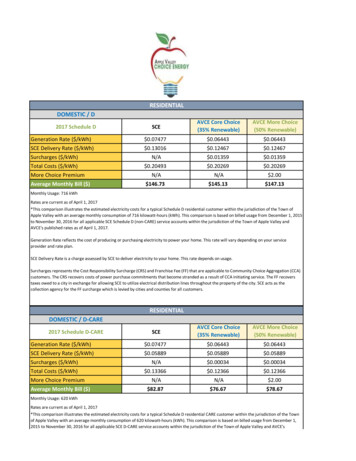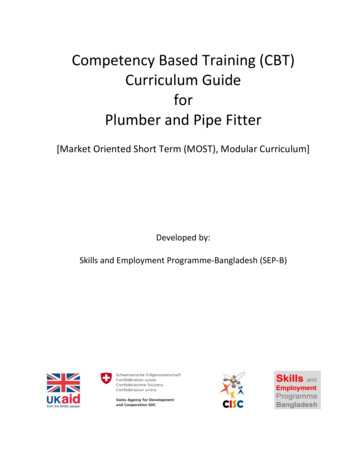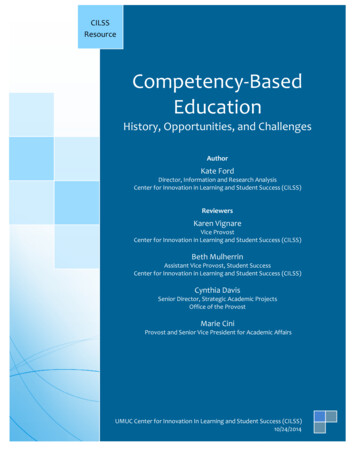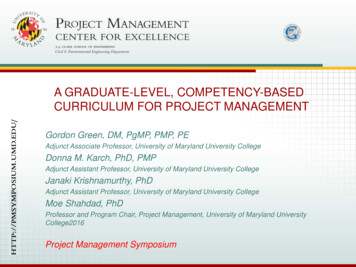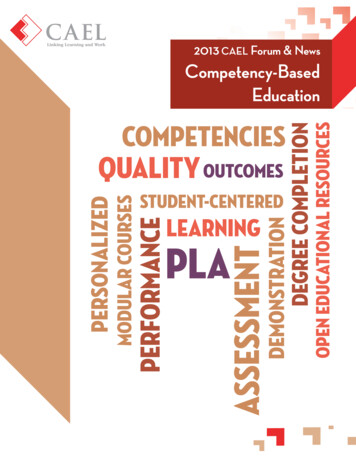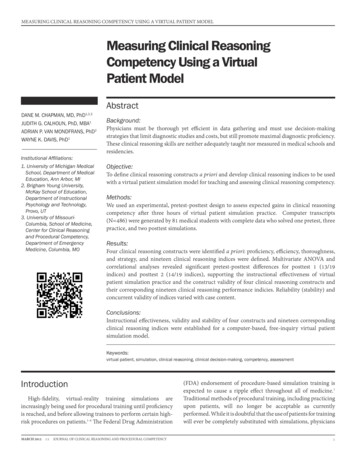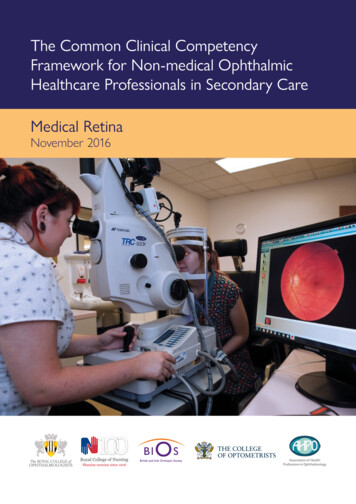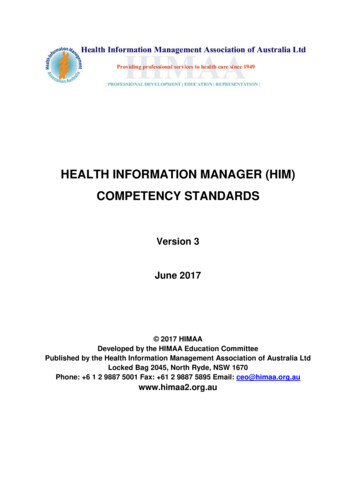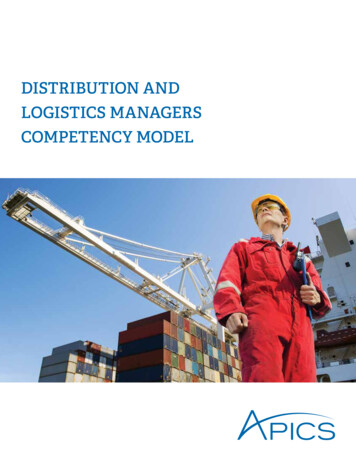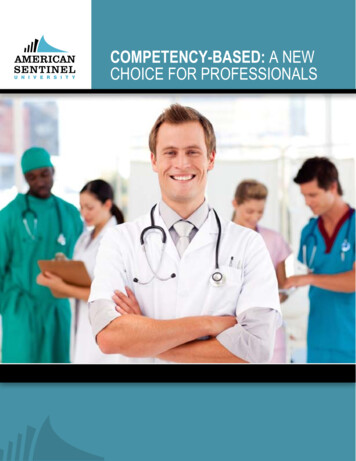
Transcription
Competency-Based: A NewChoice for Professionals
TABLE OF CONTENTSINTRODUCTIONINTRODUCTION3Competency-Based Learning4Example of a Competency-Based Degree Program7Is Competency-Based Education Right for You?11Conclusion12Education can make or break professional success in life. Data from theBureau of Labor Statistics shows that the median income of someone witha bachelor’s degree is 65 percent higher than someone who graduatedonly from high school. With a master’s degree, the difference is double.1In addition to improving earnings, advanced degrees help increasemarketability, bolster professional reputation, and open new avenues foradvancement. Employers also gain from “better quality employees whostay on the job longer, at least in part to keep making use of that benefit.”2Little wonder why the annual production of master’s degrees at the nation’sschools of higher education jumped by 63 percent from 2000 to 2012.3Unfortunately, working professionals face challenges in attaining a master’sdegree. The traditional credit-hour structure of education puts an emphasison abstract academics in classes that are fixed in time. The logisticalrequirements and emphasis on theory can be incompatible with real-worldwork responsibilities and needs of actual companies.But there is an alternative: competency-based education. This educationalapproach can efficiently help professionals develop the requiredcompetencies they need to be successful and to contribute to an employer.Executive SummaryAdvanced degrees offer significant benefits to both individuals and theiremployers. For many working professionals, pursuing higher educationthrough the traditional credit-hour arrangement can provide somechallenges in immediate relevance, instructional style, and institutionalfocus. A new project-based, competency-focused structure that someinnovative schools have begun to offer allows students to focus on masteryof skills and knowledge in a framework that is typically speedier and abetter fit for professionals. One example is American Sentinel University’sproject-based delivery of the MBA Healthcare program, an affordably-pricedonline program that uses real-world healthcare organization projects to helpstudents complete the program in less than a year.No single instructional style or structure is appropriate for everyone. Thise-book can help both working professionals with at least a bachelor’sdegree and employers understand competency-based learning, how itcompares with the traditional credit-hour organization, and the benefitsit can offer. The reader will then see an example in American SentinelUniversity’s project-based MBA Healthcare program, an online optionstudents complete through a series of projects. The e-book also addressesthe types of people and companies that might find this instructional styleuseful.123AmericanSentinel.edu2U.S. Department of Labor, Bureau of Labor Statistics, Earnings and unemployment ratesby educational attainment; April 2, 2015; http://www.bls.gov/emp/ep chart 001.htmCappelli, Peter, Why Do Employers Pay for College?, Journal of Econometrics 121, 1-2(August 2004): 213-241m http://www.nber.org/papers/w9225.pdfAnderson, Nick, “Master’s degree programs surge at nation’s colleges and universities,”The Washington Post, May 25, 2013, education section, 91801936b8 story.htmlAmericanSentinel.edu3
Competency-BasedLearningCompetency-based learning, or CBE, is an educational concept designedto solve a number of problems that developed from the long-establishedstructure called the Carnegie credit hour. For a century, students haveenrolled in courses that take a specified number of hours a week for a setnumber of weeks. A collection of courses is the roadmap for completinggeneral and then specific requirements to attain a degree and qualify for thenext level of education.Creation of the credit hour was not intended to improve education. Rather,it was to create and manage a teacher pension system for universityprofessors. This mechanism to measure the workload of professors becamethe de facto basis for “everything from daily school schedules to graduationrequirements, faculty workloads, and eligibility for federal financial aid,”according to the Carnegie Foundation for the Advancement of Teaching,the organization established by business giant and philanthropist AndrewCarnegie to create the pension system.4The credit hour became popular because it established a format andmechanism for measuring student progress and allowed comparisonsbetween students taking the same courses, professors teaching them,the courses themselves, and schools. But there are also some significantdrawbacks to the concept.Learning activities are instructor-centered. Students must move with theclass. Even with graded evaluation, other teachers and employers canonly see that students did or did not pass, even if that performance wasmarginal. Critics say the credit hour puts emphasis on time spent in aclassroom and academic schedules, not whether someone has mastered atopic. Teachers may miss a deeper understanding of students’ weaknessesand strengths. Credit hours can also mask the quality of student learning,replacing it with quantity, and reduce transparency in education.Furthermore, there is concern that a focus on in-class hours can make itharder for schools to develop “more flexible educational designs.”5Competency-based education, or CBE, is a solution that is gaining greaterinterest. Rather than focus on schedules and measuring time in classes,CBE is concerned with defining and measuring competency. The point isnot whether Johnny and Jane showed up in class, but if they can put what4AmericanSentinel.edu45Silva, Elena, et. al., The Carnegie Unit: A Century-Old Standard in a Changing EducationLandscape, Carnegie Foundation for the Advancement of Teaching, January 2015, ations/carnegie-unit/Silvathey learned into practical application. The concept began in the 1960s asmovements to improve teacher training began to develop. Since then, therehave been multiple generations of CBE examined and tested.6CBE’s appeal comes from the ultimate goal of education: the transmissionof knowledge and skills to someone seeking to learn them. An emphasis ondemonstrable results over physical presence in a classroom enables greaterflexibility in how to achieve learning. Instead of putting instructors at thecenter of education, CBE focuses on the student, who must demonstratemastery of material to attain a degree.There are two general types of CBE. One is test-based. Students workon material, develop skills, and take tests to demonstrate that they havemastered the subject. Unfortunately, that approach offers no integrationbetween subject areas, which is critical for today’s career advancement.The second type of CBE incorporates projects into the curriculum. Ratherthan relying on a traditional test, instructors examine how the studentperforms through a series of projects that demand the application of theskills and knowledge being taught in a real-world context.CBE offers significant benefits over credit-hour education. The focus oncompetency creates a greater alignment with the desired outcome. Studentshave significant skills and abilities to offer employers after completing theirstudies. In addition, if an employer is paying for the education, it then hasa measurable sense of receiving a return on its investment because it cansee stronger correlation between what the student achieves and what thecompany needs to support the business. In other words, the education hasmore relevance to the market.Competency-based education provides students greater flexibility and workswell with distance learning. The combination of CBE and distance learningmakes this delivery method more accommodating for working professionalsand their employers. Students can schedule studies around working hoursinstead of scheduling work around the need to appear at particular locationson given days and times. As the work can be more self-paced, the learningprocess is often faster than traditional credit hour courses.There are some considerations in opting for CBE. It is best suited forconcrete skills, such as those needed in business and technology, and may6Ford, Kate, Competency-Based Education: History, Opportunities, and Challenges, UMUCCenter for Innovation in Learning and Student Success, October 24, 2014, t-review-ford.pdfAmericanSentinel.edu5
Example of aCompetency-BasedDegree Programnot be the best approach for abstract subjects. CBE programs must alsofind ways to define mastery and then create a context in which it can bedemonstrated and assessed. However, properly designed, competencebased learning experiences can be a good choice for many students.The results over time of experiments in and improvements of CBE have ledto increased interest in the approach on the part of many institutions andindividuals. The reason is competency-based education offers the promiseof delivering more of what students and organizations want and expect fromhigher education.Governments at the federal and state levels have begun to use CBE toincrease student engagement and learning effectiveness. For example, in2013 the U.S. Department of Education released guidance on providingfederal loans, grants, and work study for competency-based programs.Dozens of schools have already received authorization to participate in theExperimental Sites Initiative, authorized by Congress, with competencybased offerings. Such states as New Hampshire, Michigan, and Ohio havebegun to embrace CBE, even at the high school level. Individual districts inAlaska, Colorado, and Chicago are trying the model at all levels of study.The programs are increasingly popular among students, particularly thosewho already work and need greater flexibility in pursuing their education.Another attraction is that CBE programs can be cost-effective to complete.Individuals not only have a more flexible approach available to them thantraditional credit hour courses, but experience learning that is relevant totheir professions. After a course of study, they can demonstrate skills andknowledge that are immediately applicable to their work.Corporations are enthusiastic as well. Such major companies asMcDonald’s and Anthem BlueCross BlueShield have underwritten someefforts to give their employees access to college degrees without disruptingtheir existing work. The return on their investment is workers with usefuland proven skills that can be more relevant than a traditionally structurededucational setting emphasizing theory more that pragmatic demonstrationsof mastery.AmericanSentinel.edu6A general discussion about CBE can fall into the same theoretical trap thatcredit-hour education often does. To better understand the concept, hereis an examination of American Sentinel University’s project-based andcompetency-focused delivery of the MBA Healthcare program. The offeringis an alternative to the school’s traditional academic credit hour coursebased delivery of the MBA Healthcare.The MBA Healthcare is designed for current and future healthcareprofessionals — from nurses and healthcare administrators to vicepresidents of operations — seeking to lead in a rapidly growing andchanging industry. As is true of the traditional course-based delivery, theCBE is completely online.The two MBA Healthcare delivery methods differ in their structures. Theproject-based track provides instruction through four self-directed individualprojects, each of which involves four separate competency areas, making16 competency areas in all. Students are required to demonstrate masteryin each of the competency areas. Here is a breakout:Project 1: Organizational analysisStudents conduct a comprehensive overview of a healthcare organizationthat includes the following competencies: Analyze and define organizational mission, values, and ethics. Reviewtutorials and case studies to understand their importance. Develop a setof statements and documents. Complete a current status assessment of each area of the student’schosen healthcare organization using industry-recognized tools. Reviewall information and identify strengths, weaknesses, opportunities, andthreats and identify barriers to operating in a changing healthcareenvironment. Review and analyze the external environment of a specific healthcareorganization, including demographic analysis of regional area ofthe organization, the political and regulatory climate related to theorganization’s mission, the social and economic changes relevant to theorganization, and a competitive analysis of the marketplace. Review and analyze the current internal processes of the healthcareorganization. Critique process and policy documents from healthcareorganizations, including hiring and firing processes, staff development,information management and communication processes, servicedelivery processes, and department structures.AmericanSentinel.edu7
Project 2: Create a marketing and analytics plan in ahealthcare environmentPresent a marketing plan for a healthcare organization that includes amarket and customer analysis: Evaluate current information and management systems foreffectiveness. Critique the effectiveness of the hardware infrastructureto support the management information systems and review andanalyze the organization’s current systems for web-based marketingand social media use. Develop and assess a market research analysis for a healthcareorganization. Identify and evaluate the organizational marketingstrategies. Using recognized analytic tools, construct and modify modelsto precisely analyze specific social and economic impact on the chosenorganization. Analyze the population of a specific healthcare market. Analyzedemographics and behaviors of a regional population to stratifyhealthcare needs, review the organization’s customer satisfaction datato identify marketing weaknesses and areas of opportunity, and developstrategies for targeting specific segments of the population. Compare and contrast healthcare systems within and outside ofthe United States. Analyze trends that impact the local marketingstrategy. Examine social, cultural, and political issues that affect thelocal organization. Develop a legal and regulatory framework for doingbusiness in another country.Project 3: Create a performance improvement plan for ahealthcare organizationDevise a plan for organizational improvement in the areas of systems,human resources and finances, including a process for changemanagement. Review the internal systems and processes of several healthcareorganizations and propose an improvement plan. Use qualityimprovement tools to evaluate the organization’s systems, measuretheir effectiveness, and propose efficiency and effectivenessimprovements.AmericanSentinel.edu8 Identify the human resources utilized in the chosen healthcareorganization, critique the effectiveness of those resources, and providea plan for improving efficiency and effectiveness of the resources. Review and analyze financial statements, balance sheets, cash flowstatements and other financial documents of several healthcareorganizations to critique the financial health of the chosen healthcareorganization. Create a financial improvement plan. Review the change processes of the chosen healthcare organization.Apply current change management theories to the chosenorganization’s deficiencies. Develop a detailed operational plan toimplement a change process aligned to the mission and vision of thechosen organization.Project 4: Create a strategic implementation plan for ahealthcare organizationBring together the knowledge, skills and tools learned through masteryof the competencies to create an implementation plan for changes in ahealthcare organization. Appraise the role of the risk management function within the chosenhealthcare organization and present a risk management plan. Evaluatethe necessary policies, procedures, protocols and guidelines to monitorcompliance with applicable statutes, standards and regulations. Assess the leadership issues surrounding the implementation ofnew initiatives and design effective ways to overcome barriers to theimplementation of organizational strategies. Use leadership theoriesand best practices to understand formal and informal power structureswithin an organization. Evaluate personnel and team performance on a healthcare projectand develop a project plan to coordinate work teams from differentdepartments and from external partner organizations. Proposenecessary criteria to determine service delivery level improvement. Assemble outcomes and deliverables from all preceding competenciesinto a strategic plan for the selected healthcare organization. Proposekey initiatives to achieve strategic objectives, describe how relevantstrengths and weaknesses can be used to propose the recommendedstrategic actions, identify strategic alternatives, and synthesize thebenefits of strategic management.AmericanSentinel.edu9
Is Competency-BasedEducation Right for You?Projects may be based on an employer project or an entrepreneurialstudent-designed project. Students work with books and educationalmaterials, including interactive tutorials, videos, e-books, and resourcesin American Sentinel’s electronic library, provided within the cost of theprogram. Each competency area successfully completed results in a setof documents reflecting the new mastery, with all the materials going intoan e-portfolio. The e-portfolios are useful tools to both students and theirhealthcare employers. The students have something to help demonstratetheir abilities going forward in their career, while the employers can reviewthe documents to better understand a person’s new abilities and make fulleruse of them.For many students and employers, investing in a CBE program likeAmerican Sentinel University’s project-based and competency-focused MBAHealthcare degree program can make sense. But even with the benefits,CBE is not for all students and all circumstances.For individualsAn individual considering CBE should be interested in studies that aremore practical than theoretical. The studies should be associated withdemonstrable skills that are applicable in the person’s professional life.The student should be strongly self-motivated and thrive in less-structuredenvironments. The student’s work environment should provide ampleopportunity to create projects, while the employer should be willing tocooperate with the educational process.For employersAn employer should have a strong employee development philosophy,because a student may require the cooperation and support of projects.The organization should have a strong HR department that understandsthe specific skills employees need for their short-term and long-termdevelopment. The employer must be flexible enough to consider aneducational program not based on credit hours and also be willing tocooperate with the development of useful CBE u11
ConclusionEducation is a traditional enterprise. But the world moves on quicklyand people and organizations must adapt with it. Competency-basededucation, particularly when paired with a project orientation, offers a newapproach to learning that emphasizes mastery of practical and relevantskills and knowledge. Professionals who want to advance their careers, andemployers that want to benefit from higher-quality employees, should atleast consider competency-based education programs.If you are in healthcare administration and would like to see how a CBEprogram could help you attain your MBA, visit lthcare/mba-hc-projectbase
federal loans, grants, and work study for competency-based programs. Dozens of schools have already received authorization to participate in the Experimental Sites Initiative, authorized by Congress, with competency-based offerings. Such states as New Hampshire, Michigan, and Ohio

